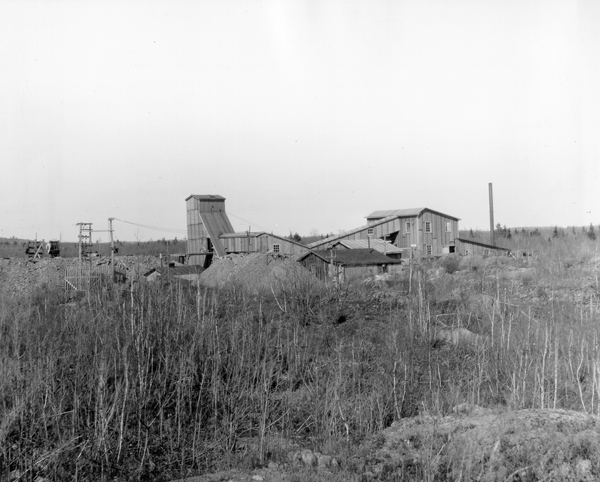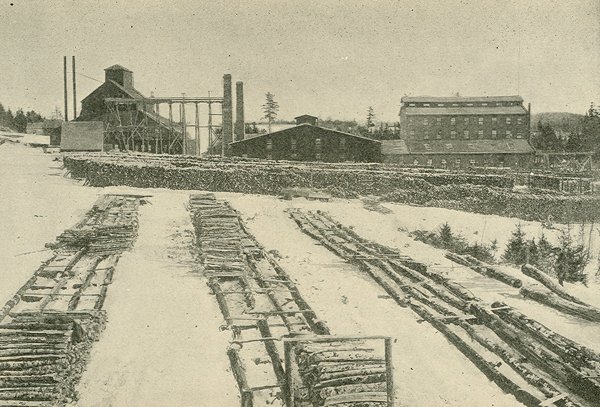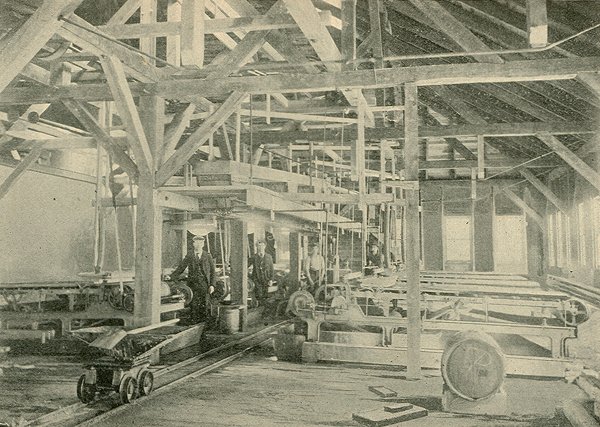We love getting questions about #mining, #minerals and #geology! We were asked about historical #gold mining in #Brookfield, #QueensCounty. Check out this thread!
#nspoli #novascotia #nshistory #cbpoli #capebreton
@GordonWilsonLNS @BernJordanMP @RegionofQueens @LHNOWnews

#nspoli #novascotia #nshistory #cbpoli #capebreton
@GordonWilsonLNS @BernJordanMP @RegionofQueens @LHNOWnews


While there were several mines in the #Brookfield #Gold District, almost all the gold produced came from the Brookfield mine operated by Wilbur L. Libbey, which was discovered in 1885.
#nspoli #novascotia #nshistory #cbpoli #capebreton
#nspoli #novascotia #nshistory #cbpoli #capebreton

In July 1886, it was acquired by John McGuire and some American associates known as the #Brookfield Milling Company. Under McGuire's management a considerable amount of ore was mined and hauled to #PleasantRiver, #Lunenburg County, for milling.
#nspoli #novascotia #nshistory
#nspoli #novascotia #nshistory

Results were good and construction of a mill at the #Brookfield mine started that year. In 1887, 1,418 ounces of #gold was extracted but mining stopped in 1888 when a break in the mineralization was encountered.
#nspoli #novascotia #nshistory #cbpoli #capebreton
#nspoli #novascotia #nshistory #cbpoli #capebreton

In 1893, John McGuire returned to the district and started preparing to reopen his old mine and treat the tailings dump by a chemical process.
#nspoli #novascotia #nshistory #cbpoli #capebreton
#nspoli #novascotia #nshistory #cbpoli #capebreton

The property soon passed into the hands of the Brookfield Mining Associates which is when Wilbur L. Libbey entered the scene as the company’s manager. Libbey was from Boston but had mining experience in Mexico and the western US.
#nspoli #novascotia #nshistory #cbpoli #capebreton
#nspoli #novascotia #nshistory #cbpoli #capebreton

He believed in a more organized, professional, scientific approach to mining than what had been used at #Brookfield previously.
Mining continued in 1894 and an incline shaft (as opposed to the vertical shaft the mine started with) was sunk in 1895.
#nspoli #novascotia #nshistory
Mining continued in 1894 and an incline shaft (as opposed to the vertical shaft the mine started with) was sunk in 1895.
#nspoli #novascotia #nshistory

In 1896 a 20-stamp mill was built and over 4500 ounces of #gold were recovered, a huge year. Work also started on building a chlorination plant to separate gold from the ore.
The chlorination process was developed by Adolph Thies of the Haile Gold Mine in #SouthCarolina.
#nspoli
The chlorination process was developed by Adolph Thies of the Haile Gold Mine in #SouthCarolina.
#nspoli

Under the supervision of his son, the largest chlorination plant in #Canada, and the first in Nova Scotia, was completed in 1897, capable of handling 16 tons of concentrates per day.
#nspoli #novascotia #nshistory #cbpoli #capebreton
#nspoli #novascotia #nshistory #cbpoli #capebreton

In 1898 a compressed air drilling plant was added to the mine to power a machine drill. This investment in technology increased production and reduced costs. As Libbey wrote: “…it would be impossible to place enough men in the mine to equal by hand the work done by power.” 

Libbey said mining and milling now cost $3.07 per ton, a huge saving over the $9.00 per ton under the mine’s previous owners.
The mine went ever deeper and its incline shaft became the longest gold mine shaft in #NovaScotia: 600 metres long, or the length of 43 school buses!
The mine went ever deeper and its incline shaft became the longest gold mine shaft in #NovaScotia: 600 metres long, or the length of 43 school buses!

In 1904 a vertical depth of over 1,000 feet was reached and a new cyanide-leaching plant, the first in #Canada, started treating both newly-mined ore and tailings. This was the beginning of the end for mercury processing.
#nspoli #novascotia #nshistory #cbpoli #capebreton
#nspoli #novascotia #nshistory #cbpoli #capebreton

Nova Scotia #gold mines haven't used mercury since the early 1900s because mercury is bad for the environment.
#nspoli #novascotia #nshistory #cbpoli #capebreton #queenscounty
@GordonWilsonLNS @BernJordanMP @RegionofQueens @LHNOWnews
#nspoli #novascotia #nshistory #cbpoli #capebreton #queenscounty
@GordonWilsonLNS @BernJordanMP @RegionofQueens @LHNOWnews

The mine shut down in 1906 after running 24 hours a day, seven days a week for 12 years. That was part of the problem. The Baptist Church was influential in the area and it opposed mining taking place on Sundays. However, water in Libbey’s mine needed to be pumped out every day. 

If the mine wasn’t pumped out on a Sunday, mining could not resume until Tuesday or Wednesday, according to Libbey.
#nspoli #novascotia #nshistory #cbpoli #capebreton
#nspoli #novascotia #nshistory #cbpoli #capebreton

The church also had concerns about drunkenness among miners and other social ills they attributed to mining. The church threatened legal action and ran a public campaign to pressure Libbey.
#nspoli #novascotia #nshistory #cbpoli #capebreton
#nspoli #novascotia #nshistory #cbpoli #capebreton

It is believed the church’s efforts may have contributed to the mine’s shutdown by making it harder for Libby to raise the capital necessary to keep it operating.
#nspoli #novascotia #nshistory #cbpoli #capebreton
#nspoli #novascotia #nshistory #cbpoli #capebreton

After his mine closed, Libbey left Nova Scotia to mine silver in Mexico. He once said of #NovaScotians that “The earth does not know a more hospitable people.”
#nspoli #novascotia #nshistory #cbpoli #capebreton
#nspoli #novascotia #nshistory #cbpoli #capebreton

Efforts to kickstart #gold mining in #Brookfield took place in the 1930s during Nova Scotia’s third gold rush but it didn’t work out.
#nspoli #novascotia #nshistory #cbpoli #capebreton
#nspoli #novascotia #nshistory #cbpoli #capebreton

A 1937 fire destroyed the mine’s offices, cookhouse, and bunkhouse and that was the end. In 1938 the electric hoist, some of the mine equipment, and most of the mill’s equipment were sent to the Lacey Mine in #ChesterBasin.
#nspoli #novascotia #nshistory #cbpoli #capebreton
#nspoli #novascotia #nshistory #cbpoli #capebreton

The #Brookfield #gold district produced a total of 43,148 ounces between 1887-1936. Its biggest year was 1905, the year before the Libbey mine closed – 4,866 ounces.
#nspoli #novascotia #nshistory #cbpoli #capebreton
#nspoli #novascotia #nshistory #cbpoli #capebreton

Brookfield is a good example of how mining adopts new technologies to increase efficiency and safety and reduce environmental impacts. In particular, eliminating mercury in processing was a huge step forward for the environment.
#nspoli #novascotia #nshistory #cbpoli #capebreton
#nspoli #novascotia #nshistory #cbpoli #capebreton

The #Brookfield mine’s geology is unusual. In most Meguma #gold mines in #NovaScotia – which is almost all our historical gold mines – the producing quartz veins were interbedded or saddle reef veins meaning they ran parallel to bedding (the layers of rock).
#nspoli #novascotia
#nspoli #novascotia

However, the Libbey vein was a cross vein, meaning it cut across the bedding. While cross veins also occur in other #gold mines, they were generally not the biggest producers in those mines, so it is unusual that the #Brookfield mine’s biggest-producing vein was a cross vein. 



• • •
Missing some Tweet in this thread? You can try to
force a refresh



























